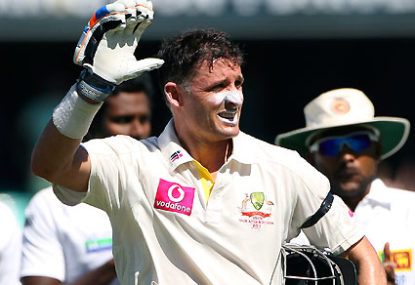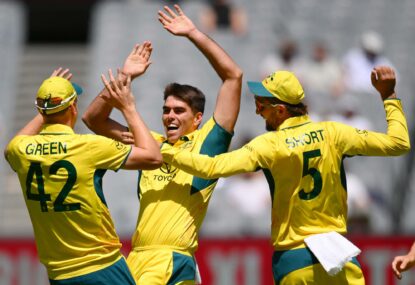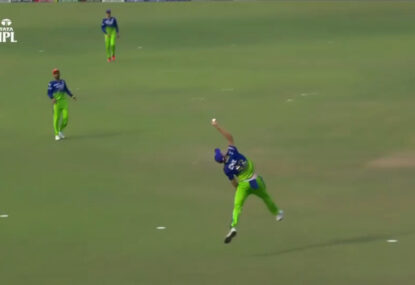“Australia’s batsmen can take Australia to a dominant position against a good bowling attack in anti-Australian conditions after the opposition has made a respectable first innings score.”
I thought that before the 2009 Ashes. Australia had a batting unit of Hughes-Katich-Ponting-Hussey-Clarke-North-Haddin. It had only been together for one series. But they had won that series. They forced Morne Morkel to be dropped for the last Test.
It was not an infallible unit. Yet it was a unit where a defeat never felt inevitable before they had a chance to bat. With six specialist batsmen, this Australian side was more geared towards the making of a big partnership rather than the breaking of a big partnership.
The English bowling unit was also relatively new. It didn’t come with as great credentials. They had won against the West Indies in England, but they had lost to the West Indies in the West Indies.
They were more recognisable for their limitations than for their strengths. Andrew Flintoff was great, but his constant injury problems weren’t. James Anderson was an Ashes name, but he was only as yet an Ashes name as a punch line.
Stuart Broad and Graeme Swann were not yet Ashes names. Neither were Mitchell Johnson, Peter Siddle or Ben Hilfenhaus, but their success in South Africa triumphed anything Broad or Swann had achieved as part of this English Test bowling unit.
Monty Panesar had had better Ashes experiences than James Anderson. But he was in this English team because England seemingly had the spin advantage after 14 years of facing Shane Warne and Stuart MacGill.
The plan was to milk that advantage for all it was worth. Force Australia to agonise over Nathan Hauritz. Laugh at them if they picked him. Laugh at them if they didn’t pick him.
When they started bowling at Cardiff, England had 435 runs, bowlers happy from a morning of happy hitting, the conditions they had ordered, and Andrew Flintoff in that mood.
When they finished bowling at Cardiff, England had a 239-run deficit and Paul Collingwood’s off-cutters to six men on the fence, a tired Andrew Flintoff, a major headache over their bowling attack and a final day stand against the spinner they had planned to laugh at looming.
It was Australia’s “perfect” match with the bat. But it was this generation of Australian players’ “oh, so nearly” match. Things never were quite as good away from home for Australia for this generation.
The next match was the match in which Australia lost their Lord’s citadel. England commanded the match from the start of Johnson’s struggles on the first day. Australia couldn’t recover from their first innings failures with bat and ball, even though Michael Clarke and Brad Haddin both valiantly tried to prove the adage – “a billion here, a billion there, and sooner or later, you’re talking real money” – in the fourth innings.
Ever since the 2005 Ashes, Australia had wanted a back-up fourth seamer in the team. They were forced to abandon that for the first two Tests of the redemption Ashes when Shane Watson was injured and Andrew Symonds wasn’t good enough yet. They had been forced to have a spinner as the back-up fifth bowler in Nagpur in 2008 and South Africa in 2009.
In Nagpur, it was what the conditions demanded, with Cameron White and Jason Krejza both playing. In South Africa, it was what the make-up of the Australian attack demanded, with Marcus North’s bowling being cast in the role of secondary bowler rather than that of a part-timer.
But it was only those first two Tests of the redemption Ashes were, even allowing for Clarke’s ability with the ball, that the idea was to only use four bowlers. Australia remained a team designed to equally be capable of building a big partnership and breaking a big partnership. But Shane Warne and Glenn McGrath were special bowlers. Their eventual long-term replacements where Mitchell Johnson and Nathan Hauritz.
Johnson had come into the Australian team immediately after McGrath’s retirement. The 2009 Ashes was the first time where Hauritz was alone in Australian spin bowling. Everyone else had been tried and discarded.
If there was a desire for a fifth option even during Warne and McGrath, it should not be surprising to find that a performance like Lord’s would reignite the desire for such a player in the Australian team for the next Test at Edgbaston – a back-up fourth seamer as insurance.
Andrew McDonald had been the fourth seamer in South Africa. But between Newlands and Cardiff, he had gone from a playing member of the side to a back-up to either Shane Watson or Stuart Clark. In short, he had become a back-up to a back-up.
Shane Watson was the man in mind. No one had anything against McDonald personally, but Watson was seen as a potential top six Test batsman. Four Tests had been enough for Australia conclude McDonald was not.
If Australia wanted a fifth bowling option, Watson would have to come in at the expense of a batsman. Five centurions over two Tests left two options: Phillip Hughes, or Michael Hussey.
Andrew Flintoff had beaten Hughes in Cardiff. James Anderson had beaten his much worked-on pull shot in the first innings at Lord’s. A disgraceful piece of umpiring, disgraceful because of its inconsistency, had ended an unconvincing second innings at Lord’s.
Flintoff had the advantage. But it wasn’t a fait accompli that Hughes would be dropped. He had had the series of his life in South Africa. He was the next promised great batsman of Australian cricket.
Michael Hussey had come down from his initial high in Test cricket. His struggles went well beyond the first two Tests, to the start of the previous Australian summer. Michael Clarke and Marcus North could slide up a place, or North could jump to four, and Watson could slide into the team at No.6, the all-rounders position.
Yet Hussey had scored a half-century at Lord’s. No English bowler seemed to have the same hold on him that Flintoff had on Hughes. A struggling opening batsman means a constant early wicket.
When viewed in this light, the decision to replace Hughes with Watson is understandable. Perhaps the biggest mistake was the search for why. Sometimes, you have to feel. The feeling was that Watson would be the best opener for the next three Tests.
In something he has never been given enough credit for, Watson justified the feeling of the selectors and Ponting. Yes I am separating the selectors and Ponting, because although Ponting always had a say, he never had a vote.
For at least the next three Tests, Australia’s team was focussed more around the breaking of a big partnership, rather than the making of a big partnership. It didn’t know it, but the inability to make big partnerships under pressure would be a persistent problem for the next seven years. That failure wasn’t on one specific player – it was communal.





































































































